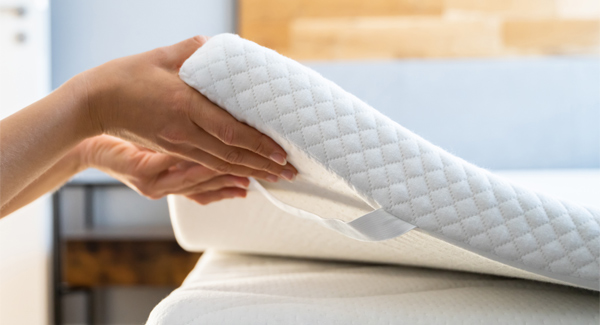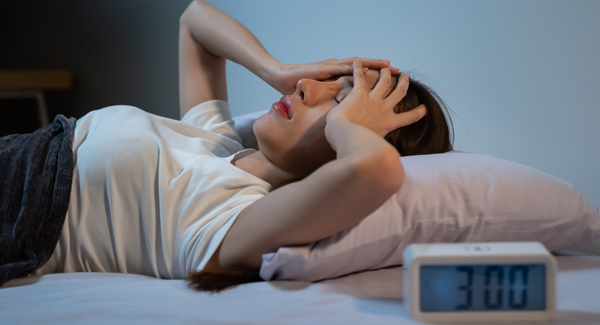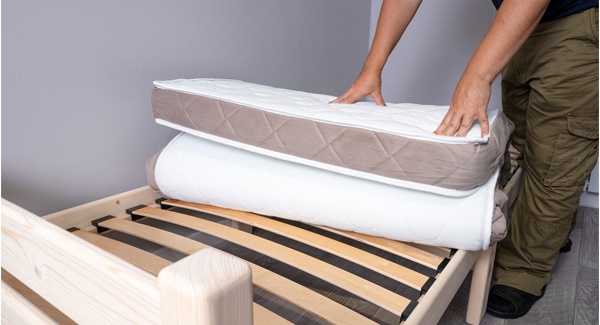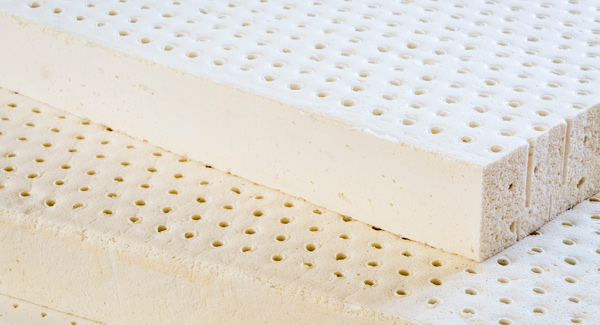Home » Mattress advice » How Often Should You Change Your Mattress?
How often should you change your mattress?
Article navigation
- Tony Brown
The typical lifespan of a mattress is between 7 and 10 years. Some mattresses may last longer, while others may need replacing sooner.
A mattress should be replaced when it is no longer comfortable, supportive, affects your sleep, or you wake up feeling worse than when you went to bed. A mattress will also need replacing when it begins to fail or sags excessively.
Some people may be willing to replace their mattresses more frequently for health and hygiene reasons. We lose around half a pint of body moisture each night and shed dead skin cells into the mattress.
As well as hygiene reasons, some people may replace their mattresses sooner to take advantage of the latest mattress technologies.
How can you tell when you need a new mattress?
Some people may become accustomed to the feel of an old unsupportive mattress. Others may put off buying a new mattress and prefer to buy a new car or go on holiday instead.
We should all be investing in good quality sleep. If you try sleeping on an uncomfortable mattress, whether it’s lumpy or causing you aches and pains, you’ll wake up feeling worse than you did before you went to bed.
Several signs may indicate your mattress is past its best.
Wear and tear
Wear and tear occurs naturally over time. Mattress sagging is a common issue in older mattresses. You may notice that your old mattress is lumpy and showing permanent indentations. This may indicate that the components inside the mattress are failing and that it may no longer be supporting you correctly.
Sleeping on a sagging mattress can contribute to pain in the neck, shoulders, hips, and back due to poor spinal alignment. You may even start to feel the springs through the mattress or find it difficult to turn over in bed. If the springs squeak, this could also indicate that the mattress needs replacing.
Discolouring or staining of the mattress may be evident in older mattresses, particularly where a mattress protector has not been used.
You sleep better elsewhere
Sleeping better elsewhere is usually an indication that your old mattress is no longer performing as it should. If you sleep better on the spare bed or the sofa, or feel rejuvenated after a good night’s sleep in a hotel bed, you may need to replace your mattress.
It’s affecting your sleep
Your mattress plays a crucial role in sleep quality. If you’re uncomfortable in bed or waking up feeling achy, tired or groggy, your mattress may be due for an upgrade.
Allergy and asthma flare-ups
An old mattress may cause allergy or asthma flare-ups. Every night we lose around half a pint of body moisture and shed roughly a pound of dead skin each year, mainly into the mattress. This provides the perfect breeding ground for dust mites to thrive, which can trigger allergic reactions or asthma attacks.
Regular mattress cleaning may help, but it may be time to change your mattress if symptoms persist.
Your sleeping partner is keeping you awake
Older mattresses are less effective at reducing movement across the mattress. If you and your sleeping partner disturb one another at night, your old mattress could be the problem.
What factors determine how long a mattress lasts?
The average lifespan of a mattress is around 7 to 10 years. Some mattresses may need replacing sooner, while others may last longer. The lifespan of a mattress depends on its construction, the quality of its materials, how it is used and looked after.
The type of mattress you sleep on
The type of mattress you sleep on can make a difference in how long it lasts.
Open coil
An open coil mattress is made from a continuous wire wrapped around to form a coil. These coils are then linked together to create a spring unit. They are often cheaper than most other mattress types as they can be mass-produced by a machine quickly and easily.
As the springs work as one unit, you tend to feel your sleeping partner’s movement more in bed, which will worsen over time. Because of this, you may replace the mattress sooner than expected.
Open coil mattresses are less robust than other mattress types and generally wear out quicker. They are not as supportive and may not be suitable for sleeping partners of different body weights.
The typical lifespan of an open coil mattress is around 6 to 10 years.
Pocket springs
Pocket spring mattresses are more supportive and generally last longer than open coil mattresses.
A pocket spring mattress contains individual springs encased in fabric pockets and stitched or hand-tied together. The pocket springs work independently and reduce movement and ‘roll-together’. Weight is evenly distributed across the mattress.
Pocket springs provide good edge to edge support. In higher-quality mattresses, hand-side stitching is used to further strengthen the support around the edges while helping the mattress maintain its shape for longer.
A pocket spring mattress may last beyond 12 years if it is looked after correctly. Some pocket spring manufacturers like Vi Spring even offer a 30-year guarantee on their mattresses.
Pocket springs mattresses often come in various mattress tensions to cater for sleeping partners of different body weights. This ensures each sleeper remains correctly supported.
Memory foam
Memory foam mattresses consist of multiple layers of foam that range in thickness. Each memory foam mattress has its combination of layers, starting from a durable base layer and progressing to a softer top comfort layer. Because of this, you can only sleep on the top side of the mattress as the underside is not suitable for sleeping on.
One drawback of memory foam mattresses is that all the body weight is concentrated on a single sleeping surface, so they may not be as durable as double-sided mattresses.
A good quality memory foam mattress containing high-density foam can last up to 15 years. In contrast, ordinary memory foam in cheaper models can break down faster than expected.
Latex
Natural latex is durable, resilient and maintains its shape over time. The durability and longevity of a latex mattress depend on whether the latex is natural or synthetic. If looked after, natural latex mattresses can last up to 15 years.
Non-turn mattresses
Some mattresses are single-sided and are not intended to be flipped over. As all the body weight is concentrated on a single sleeping surface, one-sided mattresses tend to have a shorter lifespan than double-sided mattresses.
Mattress Fillings
There are a wide variety of fillings in mattresses that can affect their longevity. Synthetic fibres like polyester are cost-effective and often found in cheaper mattresses. Natural materials, such as wool and cotton, are often used in better quality mattresses and are more resilient and longer-lasting.
How much weight you apply to the mattress
A mattress used by a heavier person is likely to wear out quicker than a mattress used by someone lighter. Similarly, a mattress that two people share will probably wear out faster than a mattress used by a single person.
Your mattress may also be affected by changes in your appearance. For example, if you have put on weight, your mattress may not be supporting you correctly and could wear out sooner.
Also, if you sit on the edge of the bed or allow children to jump up and down on the mattress, this puts pressure on the components, which may reduce the mattress’s lifespan.
The bed base your mattress is paired with
The lifespan of a mattress can be affected by the type of bed base it rests on. Ideally, the mattress and the bed base should be purchased together to ensure that the mattress is correctly supported.
Pairing a mattress with its matching bed base will not only improve the level of comfort and support, it can also extend its lifespan. For example, a sprung divan base helps cushion the mattress, removing some of the stress and strain from the sleeper’s body weight. It can also enhance the overall comfort by up to 40%
On the other hand, pairing a mattress with an old worn-out bed base will significantly reduce its lifespan. It may also invalidate the manufacturer’s guarantee. Similarly, putting a mattress on a slatted bed base where the gap between the slats exceeds the manufacturer’s recommendations will cause the mattress to sag between the gaps, reducing its lifespan.
Mattress care
With correct care, you can keep your mattress in good condition and extend its life.
You should always cover your mattress with a good quality, breathable mattress protector. A mattress protector provides a clean and safe sleeping environment and protects your mattress against spills, moisture and bodily fluids. Any liquids will absorb into the mattress without one, leaving discoloured patches and permanent stains.
You should also turn your mattress to help even out the wear and prevent it from sagging.
If your mattress sits on a bed frame, you should place a mattress pad or breathable blanket onto the slats to protect the mattress from indentations and splinters.
Final thoughts
Like most things in life, you generally get what you pay for with mattresses. With correct care, a well-made mattress can last up to ten, twenty or even thirty years. On the other hand, you should not expect a cheaper mattress to stand the test of time.
Learn more

About the author
Tony Brown is the founder and creator of The Bed Consultant. His career in the bed industry began in 2002. After graduating from university with a degree in Business Administration, Tony joined one of the largest independent furniture retailers in the UK as a bed consultant. Tony has helped thousands of customers find the perfect mattress.





